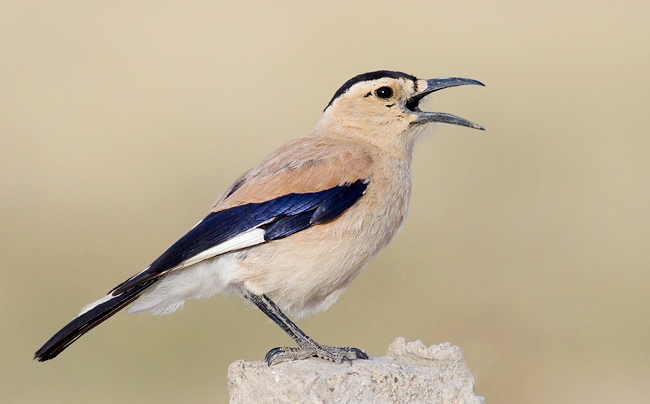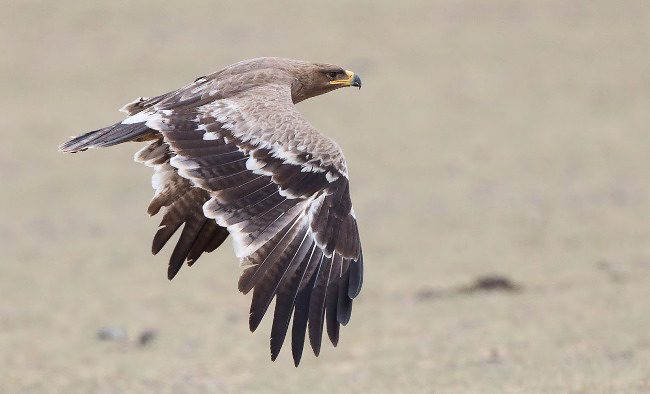

A striking male Oriental Plover in the Gobi Desert near Dalanzadgad by Simon Colenutt.
- One of the last wild places
- Where the bird specialities include Altai Snowcock, Black-billed Capercaillie, Demoiselle and White-naped Cranes, Pallas’s Fish-eagle, Oriental Plover, Relict Gull, Pallas’s Sandgrouse and Mongolian Ground-jay
- Other localized birds include Mongolian Lark, Mongolian Accentor, White-throated Bushchat, and Eversmann’s and Güldenstädt's Redstarts
- And more widespread spectacular birds include Bar-headed Goose, Lammergeier, Saker Falcon, Azure Tit and Wallcreeper
- There are also a few mammals, such as Argali, Siberian Ibex, Mongolian Gazelle, Great Gerbil, Siberian Chipmunk, pikas
and sousliks - All in one of the least densely populated countries on earth with boreal forest, vast grass steppes, the Gobi Desert, the Altai Mountains and many lakes and marshes

A terrific image of a Henderson's or Mongolian Ground-jay by Dubi Shapiro.
- To stand a chance of seeing wild Bactrian Camels, one of rarest animals left on Earth, it is necessary to mount a mini-expedition to the remotest parts of the Gobi Desert but this is possible and in the Great Gobi Reserve A it is also possible to see 'Gobi' Brown Bear (most likely at Shar Xuls Research Station where there are feeding stations), Saiga, Asiatic Wild Ass and Long-eared Hedgehog.
Best Birds and other wildlife in Mongolia
Birds
The lists below are for the northern spring.
Near-endemics
Mongolia and Russia 1 Black-billed Capercaillie.
Mongolia, Russia and China 4 Mongolian (Henderson’s) Ground-jay, Mongolian Lark, Reed Parrotbill and Small (Pere David’s) Snowfinch.
Mongolia and China 1 Mongolian (Kozlov's) Accentor.
Other specialities
Altai Snowcock, Pallas’s Fish-eagle, Demoiselle and White-naped Cranes, Oriental Plover, Swinhoe’s Snipe, Asian Dowitcher, Relict Gull, Pallas’s
Sandgrouse, Azure Tit, Chinese Grasshopper-warbler, Eversmann’s and White-winged (Güldenstädt's) Redstarts, White-throated (Hodgson’s) Bushchat,
Red-throated Thrush, Altai Accentor, Pallas’s (Reed) Bunting, Mongolian Finch, Chinese Beautiful Rosefinch, Saxaul Sparrow and Brandt’s Mountain-finch.
Also a chance of Falcated Duck, Asian Houbara (Macqueen’s) Bustard and Great Rosefinch.
Others
Whooper Swan, Bar-headed and Swan Geese, Ruddy Shelduck, Stejneger’s Scoter, Daurian Partridge, Black Stork, Lammergeier, Cinereous (Eurasian/Black) and
Himalayan Griffon Vultures, Golden and Steppe Eagles, Upland Buzzard, Amur and Saker Falcons, Common Crane, Sociable Lapwing, Black-winged Stilt, passage
migrant shorebirds including Ruff, Great Black-headed (Pallas's) Gull, Caspian and White-winged (Black) Terns, Hill Pigeon, Pacific Swift, (Eurasian)
Hoopoe, Black, Grey-headed, Eurasian Three-toed and White-backed Woodpeckers, Brown, Isabelline and Great (Steppe) Grey Shrikes, Northern (Eurasian)
Nutcracker, Red-billed Chough, Daurian Jackdaw, Asian Short-toed and Shore Larks, White-crowned Penduline-tit, Arctic, Asian Desert and Thick-billed
Warblers, Pallas’s Grasshopper-warbler, Desert, Isabelline and Pied Wheatears, Siberian Rubythroat, Daurian Redstart, Rufous-tailed Rock-thrush, Eye-browed
Thrush, White-cheeked Starling, Alpine and Brown Accentors, Blyth’s and Olive-backed Pipits, Citrine Wagtail, Black-faced, Godlewski’s, Grey-necked, Meadow
and Pine Buntings, Twite, Long-tailed Rosefinch and (White-winged) Snowfinch. Also a chance of Hazel Grouse, Baillon’s Crake, Lesser (Mongolian)
Sandplover, Eurasian Eagle and Ural Owls, Siberian Jay, Siberian Tit and Asian Rosy-finch.

A great image of a Steppe Eagle in the Gobi near Dalanzadgad by Simon Colenutt.
Mammals
Argali, Siberian Ibex, Goitered and Mongolian Gazelles, Corsac Fox, Andrew's Three-toed, Long-eared and Northern Three-toed (Hairy-footed) Jerboas, Great,
Midday and Mongolian Gerbils, Alpine, Daurian, Northern and Pallas’s Pikas, Siberian (Tarbagan) Marmot, Red-cheeked and Long-tailed
Sousliks, and Siberian Chipmunk. Also a chance of Beech Marten, and an outside chance of Snow Leopard, Pallas's Cat, Wolf, and Marbled and Steppe Polecats.
Saiga occurs in Sharga NR near Altai City. Przevalski’s Horse has been reintroduced into Hustai (Khustain Nuruu) NP.
Other Natural Wonders in Mongolia
Altai Mountains
‘Altai’ means gold in Kazak and Mongolian languages and there’s plenty of it in these scenic mountains which rise to 4506 m (14,784 ft) at Gora Belukha
on the border between Kazakhstan and Russia.
Singing Sands (Khongoryn Els)
So called because of the noise made by the unusual round and smooth grains of sand as they are blown across the surface of these dunes in the southern
Gobi Desert. Some of the largest sand dunes in the world are also present here in Gobi Gurvan Saikhan National Park.
‘Flaming Cliffs’ (of Bayanzag)
The sandstone here in the southern Gobi seems to glow at dusk, although the site is arguably more famous for dinosaur fossils. Over 100 have been found
here, including velociraptors, since Roy Chapman Andrews, an American palaeontologist, discovered the first fossilized dinosaur eggs in 1923.
Best Sites for Birds and other wildlife in Mongolia
- Tuul River, Ulaanbaatar (Ulan Bator) Hill Pigeon, Azure Tit, White-crowned Penduline-tit, Meadow and Pine Buntings, and Long-tailed Rosefinch.
- Gun Galuut NR Swan Goose, White-naped Crane, Pallas’s Bunting and Argali.
- Gobi Desert via Dalanzadgad (570 km south of Ulaanbaatar) (including the wetlands of Orog Nuur and Boon Tsagaan Nuur, and Singing Sands (Khongoryn Els) and the ‘Flaming Cliffs’ of Bayanzag) Bar-headed and Swan Geese, Pallas’s Fish-eagle, Common and Demoiselle Cranes, Oriental Plover, Asian Dowitcher and other, passage migrant, shorebirds, Great Black-headed and Relict Gulls, terns, Pallas’s Sandgrouse, Mongolian Ground Jay, Asian Desert Warbler, Mongolian Finch, Saxaul Sparrow (Khongoryn Els) and Small Snowfinch, as well as Goitered and Mongolian Gazelles. Also a chance of Baillon’s Crake and Argali.
- Gobi Gurvan Saikhan NP including Yolyn Am (Gorge), out of Dalanzadgad Altai Snowcock, Lammergeier, Himalayan Griffon, Golden Eagle, Saker Falcon, White-winged Redstart, Wallcreeper, Alpine, Brown and Mongolian Accentors, Godlewski’s Bunting, Chinese Beautiful Rosefinch, White-winged Snowfinch, Siberian Ibex, Mongolian Gerbil and Pallas's Pika. Also a chance of Great Rosefinch and Beech Marten, and an outside chance of Snow Leopard, Pallas's Cat, and Marbled and Steppe Polecats.
- Orog(nwr) Lake, near Bogd Relict Gull.
- Baga Bogd Mountain Altai Snowcock, White-throated Bushchat, Altai Accentor and Asian Rosy-finch.
- Barig Mountain Altai Snowcock, White-throated Bushchat and Asian Rosy-finch.
- Sangiin Dalai Nuur (steppe lakes) Whooper Swan, Stejneger’s Scoter, Demoiselle Crane and Mongolian Lark.
- Bayan Nuur Swan Goose and White-naped Crane.
- Hustai (Khustain Nuruu) NP Daurian Partridge, Golden and Steppe Eagles, Amur and Saker Falcons, Mongolian Lark, Corsac Fox and Siberian Marmot. Also a chance of Wolf and Steppe Polecat. Przevalski’s Horse has been reintroduced here.
- Gorkhi Terelj NP White-backed Woodpecker and Azure Tit. Also a chance of Hazel Grouse, Ural Owl, Siberian Jay and Siberian Tit at Gachuurt at southwest edge of the NP.
- Khentiy Nuruu Mountains (including Jalman Meadows) Black-billed Capercaillie, Swinhoe’s Snipe, Black, Grey-headed, Eurasian Three-toed and White-backed Woodpeckers, Nutcracker, Chinese Grasshopper-warbler, Red-flanked Bluetail and Siberian Chipmunk. Also a chance of Hazel Grouse and Ural Owl.
Best Times for Birds and other wildlife in Mongolia
Late May-early June is the peak time to visit Mongolia, when most of the bird summer visitors have arrived and many passage migrants are moving through although this is usually too late to see Black-billed Capercaillies in full display. The Gobi is a dry desert not a hot one – be prepared for cold temperatures, especially at night, and snow even in June.
Recommended Bird Books etc. for Mongolia
Birds of Mongolia by S Gombobaatar and C Leahy. Helm, 2019.
A Field Guide to the Birds of Mongolia by D Ganbold and C Smith. John Beaufoy Publishing Ltd, 2019.
Birds of East Asia by M Brazil. Helm/PUP, 2009.
A Field Guide to the Birds of China by J MacKinnon and K Phillipps. OUP, 2000.
Collins Bird Guide by L Svensson et al. Collins, 2010 (Second Edition).
Birds of Europe by L Jonsson. Helm, 1999.
A Guide to the Mammals of China by A Smith, Yan Xie et al. PUP, 2008.
The Mammals of China by Sheng Helin et al. China Forestry Publishing House, 1999.
Where to watch birds in Asia by N Wheatley. Helm, 1996.
Don’t know which country/countries/regions to visit in Asia? Then it may be worth considering taking a look at this book, written by this website’s author. It is many years old of course but it still provides a starting point, an overview and a guiding light to the best birds and the best places to look for them in the region, and could save hours of searching for similar information on the internet. However, it is important to check more up-to-date sources for sites which have been opened up, sites and species which have been discovered, lodges that have been built etc. since the book was published.
Birding and Wildlife Trip Reports for Mongolia
Many trip reports, some for Mongolia, are posted on the websites listed here. On some of these websites some reports are independent and some are posted by tour companies who organize tours to Mongolia. These tour companies and others also post their own reports on their websites, which are listed under 'Some Organized Tours to Mongolia' below.
- The best website for trip reports is CloudBirders
- but these are also worth a look
- Birdtours
- Fatbirder
- Jon Hornbuckle
- Mammal Watching
Local bird and wildlife guides in Mongolia
The costs of organized tours partly reflect the quality of the tour leaders. Some leaders are certainly better than others and many companies claim their leaders are the best but even the best rely at least to some extent on the exceptional skills of the local guides they employ. If you are travelling independently, employing such local guides will greatly increase your chances of seeing the wildlife you wish to see.
Accommodation for birders in Mongolia
Some Organized Tours for birds and other wildlife to Mongolia
There are many tour companies who organize tours to see mammals, birds, other wildlife and other natural wonders. The cost of these tours vary considerably according to such variables as the airlines used, the number of days the tours last, the number of sites visited, the number of people in the group (an important consideration if you wish to see such wildlife as rainforest mammals and birds), the number of tour leaders, the standard of accommodation and transport, and the percentage profit the company hopes to make. Generally, where the number of days tours last and the number of sites visited are similar, the cheapest tours are those that use the cheapest airlines, accommodation and local transport, that have the largest groups with the least number of leaders, and that make the least amount of profit. The most expensive tours tend to be those which are exceptionally long, use the most expensive accommodation (ridiculously lavish in some cases, even for single nights) and which make the most profit. Some tour costs partly reflect the quality of the tour leaders. Some leaders are certainly better than others and many companies claim their leaders are the best but even the best rely at least to some extent on the exceptional skills of the local guides they employ.
While tour companies organize tours with set itineraries many also organize custom tours for individuals and private groups who instead of taking a tour with a set itinerary want to follow their own itinerary to suit their own personal tastes, whether it be mammals, birds, other wildlife, other natural wonders or even man-made attractions, or a mixture of them all. Many organized tours with set itineraries are also fast-paced and target as many species as possible, whether they are mammals, birds or other wildlife or everything, which usually leaves little time to enjoy the best sites and individual species, but on a custom tour those taking part can specify the pace and the sites and species they wish to concentrate on. Custom tours also suit people who like to travel with people they already know, rather than with a group of strangers, and they are popular with people with partners with different interests. Individuals, partners and small groups will almost certainly have to pay more for a custom tour than an organized tour with a set itinerary but a large group of friends may be able to travel for less than the price quoted for a set tour.
Tour companies who run organized tours to Mongolia include the following. Many of these also offer custom tours.
- Birdfinders
- Birdquest
- Sunbird
- Victor Emanuel Nature Tours
- Wise Birding Holidays
- We are a small wildlife watching holiday company based in Devon (UK) specialising in birdwatching and mammal watching holidays across the world. What sets us apart from other wildlife watching companies is quite simple:
- 1 – small group sizes: (average between 4 – 8 people)
- 2 – a commitment to conservation: (donation after each tour)


